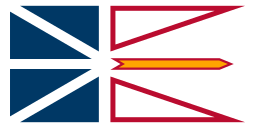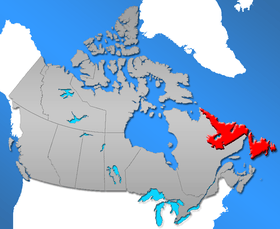Government of Newfoundland and Labrador
The Government of Newfoundland and Labrador refers to the provincial government of the province of Newfoundland and Labrador. It was established by the Newfoundland Act and its powers and structure are set out in the Constitution Act, 1867.
 Wordmark | |
| Formation | 1949 |
|---|---|
| Country | Canada |
| Website | gov.nl.ca |
| Legislative branch | |
| Legislature | House of Assembly |
| Meeting place | Confederation Building |
| Executive branch | |
| Main body | Executive Council |
| Head of Government | Premier |
| Viceregal Representative | Lieutenant Governor |
| Judicial branch | |
| Court | Supreme Court |
| Seat | St. John's |
 |
|---|
| This article is part of a series on the politics and government of Newfoundland and Labrador |
|
|
| See also |
| Politics by state / territory |
Lieutenant-Governor of Newfoundland and Labrador
This arrangement began with the 1949 Newfoundland Act,[1] and continued an unbroken line of monarchical government extending back to the late 15th century. However, though Newfoundland and Labrador has a separate government headed by the Queen, as a province, Newfoundland and Labrador is not itself a kingdom.[2]
Government House in St. John's is used both as an official residence by the Lieutenant Governor, as well as the place where the sovereign and other members of the Canadian Royal Family will reside when in Newfoundland and Labrador. The mansion is owned by the sovereign in her capacity as Queen in Right of Newfoundland and Labrador, and not as a private individual; the house and other Crown property is held in trust for future rulers and cannot be sold by the monarch except by her Lieutenant Governor with the proper advice and consent from the Executive Council of Newfoundland and Labrador.
Ministries
%2C_St._John's%2C_Newfoundland%2C_Canada.jpg)
- Advanced Education, Skills and Labour
- Child, Youth and Family Services
- Education and Early Childhood
- Municipal Affairs and Environment
- Finance
- Fisheries and Aquaculture
- Department of Services NL
- Health and Community Services
- Business, Tourism, Culture and Rural Development
- Department of Justice and Public Safety (Newfoundland and Labrador)
- Justice and Public Safety
- Natural Resources
- Seniors, Wellness and Social Development
- Transportation and Works
- Labrador and Aboriginal Affairs
- Department of Innovation, Business and Rural Development
References
- George VI (23 March 1949), Newfoundland Act, 8.1, Ottawa: King's Printer for Canada, retrieved 16 June 2009
- Forsey, Eugene (31 December 1974), "Crown and Cabinet", in Forsey, Eugene (ed.), Freedom and Order: Collected Essays, Toronto: McClelland & Stewart Ltd., ISBN 978-0-7710-9773-7
